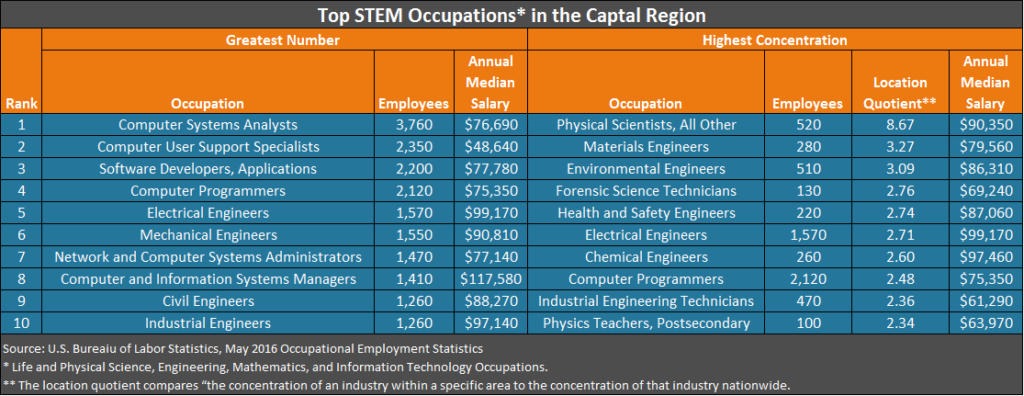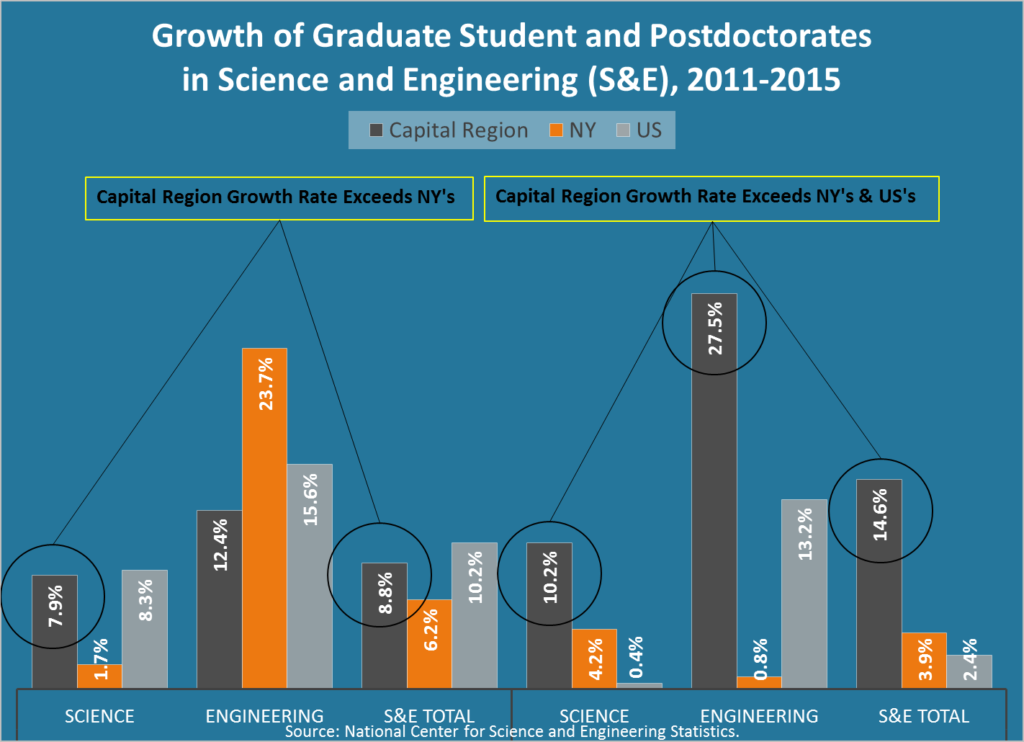Capital Region’s STEM Pipeline is Flowing Faster
Science graduate student enrollment growth outpaces state, nation for postdocs
The Capital Region’s pipeline of highly educated talent is expanding, with area colleges and universities enrolling science graduate students and postdoctorates at rates faster than those for state. Even more, area institutions are awarding greater numbers of science, technology, engineering and mathematics (STEM) degrees.
Pipeline for STEM Careers
This pipeline of STEM graduates is crucial to supporting the region’s scientific research and development (R&D), software development, life sciences, advanced materials, clean energy and semiconductor clusters. The Albany-Schenectady-Troy metropolitan area (MSA) has thousands of computer, software, engineering and technician positions, according to a Center for Economic Growth (CEG) analysis of U.S. Bureau of Labor Statistics data. The area’s above-average concentrations of various types of engineers and scientists also make it unique and attractive to tech companies.

STEM Graduate Enrollment
In fall 2015, eight Capital Region higher education institutions1 enrolled 3,631 science and engineering (S&E) graduate students, up 8.8 percent from five years earlier. That was above the state’s growth rate of 6.1 percent but below the nation’s rate of 10.2 percent, according to a Center for Economic Growth (CEG) analysis of data from the National Center for Science and Engineering Statistics (NCSES). Capital Region institutions also enrolled 457 graduate students in the STEM-related health field. Data for this field from 2011 is not available.
Driving the region’s growth in S&E graduate students in fall 2015 were the College of St. Rose, Union Graduate College (now Clarkson University Capital Region campus), Sage Colleges and Rensselaer Polytechnic Institute (RPI), where enrollments were up 121.4 percent, 45.7 percent, 33.9 percent and 14.7 percent, respectively.
STEM Postdoc Appointments
The region saw even stronger growth among S&E postdoctorates at five institutions2 during the five-year period ending in fall 2015. The region’s postdoctoral appointments were up 14.6 percent, compared to 3.9 percent statewide and 2.4 percent nationwide. The University at Albany (UAlbany) and RPI drove the region’s S&E postdoctorate growth, increasing 65.7 percent and 7.8 percent, respectively. The region had 33 postdoctorates in the health field in fall 2015. That was down 35.3 percent from five years earlier, compared to down 4.4 percent statewide and down 0.7 percent nationwide.
STEM Degree Awards
On top of enrolling more S&E students, the region is graduating more of them. In the 2015-2016 school year, a dozen traditional Capital Region institutions3 awarded 2,928 bachelor’s, master’s and doctor’s degrees in seven major STEM fields (excluding health fields)4, up 8.3 percent from five years earlier, according to a CEG analysis of data from the Integrated Postsecondary Education Data System (IPEDS). The region’s two distance learning colleges, Excelsior College and SUNY Empire State College, also awarded 491 STEM bachelor’s degrees, up 30.9 percent over five years. Combined, traditional and distance learning institutions awarded 3,419 STEM degrees, or 11 percent more than five years earlier. When the 1,909 degrees awarded at traditional and distance-learning institutions in health professions and related programs are factored in, the region awarded 5,328 STEM and STEM-related degrees in the 2015-2016 school year.

Capital 20.20
The Capital Region’s five-year economic development plan, Capital 20.20, emphasizes the importance of ensuring area employers have access to a pipeline of highly skilled worker proficient in STEM. To advance this strategy, CEG sponsors events such as Girls in STEM, and is leading The Pathways Project, an advanced manufacturing careers study funded by the Columbia, Greene, Albany, Schenectady, Rensselaer, Saratoga, Warren and Washington county Workforce Investment Boards. These initiatives, coupled with those being undertaken by SUNY Poly, GlobalFoundries, miSci and others, will further strengthen the region’s STEM workforce.
Notes
1 Graduate degree-awarding institutions include Albany College of Pharmacy and Health Sciences, Albany Medical College, The College of St. Rose, Rensselaer Polytechnic Institute (RPI), The Sage Colleges, SUNY Polytechnic Institute (SUNY Poly), University at Albany (UAlbany) and Union Graduate College (now Clarkson University Capital Region Campus).
2 Institutions with postdoctoral appointees included Albany College of Pharmacy and Health Sciences, Albany Med, RPI, SUNY Poly and UAlbany.
3 STEM degree-awarding institutions included Albany College of Pharmacy and Health Sciences, Albany Med, Clarkson, Maria College, RPI, Siena, Skidmore SUNY Poly, St. Rose, Union and UAlbany.
4 STEM fields include Computer and Information Sciences, Engineering, Engineering Technologies and Engineering-related Fields, Biological and Biomedical Sciences, Physical Sciences, Science Technologies/Technicians and Mathematics and Statistics. Health Professions and Related Programs are a separately listed STEM-related field. Note: The NCSES survey of “Survey of Graduate Students and Postdoctorates in Science and Engineering” is broader in scope, covering the following fields: Agricultural Science, Architecture, Communication Fields, Computer Science, Earth, Atmospheric, and Ocean Science Fields, Engineering Fields, Family and Consumer Sciences, and Human Sciences Fields, Health Fields, Mathematical Science Fields, Neuroscience Fields, Physical Science Fields, Psychology Fields, Social Science and Multidisciplinary and Interdisciplinary Studies.
Don’t miss these insights into the trends that are shaping the Capital Region’s economy. Sign up for CEG’s e-news and follow us on:













